| Article ID | Journal | Published Year | Pages | File Type |
|---|---|---|---|---|
| 672995 | Thermochimica Acta | 2015 | 8 Pages |
•The amorphous alloy undergoes thermal stabilization in 650–710 K temperature region.•Complex crystallization DSC peak was deconvoluted into individual steps using different functions.•The use of different functions shows only slight difference between the obtained kinetic triplets.•Inhomogeneous surface morphology dependent on heating rate is observed using SEM.•Crystallization of each phase is influenced by impingement effects.
The crystallization mechanism and kinetics of Fe40Ni40P14B6 amorphous alloy were studied under non-isothermal conditions. Thermal stabilization of this alloy manifests in DSC through two complex peaks, corresponding to crystallization and recrystallization, respectively. The complex crystallization DSC peak was deconvoluted into individual steps corresponding to crystallization of individual phases, where the results using both Gaussian–Lorentzian cross-product and Fraser–Suzuki function were compared. It was determined that the values of kinetic triplets of the individual steps did not exhibit any significant difference, depending on the deconvolution function. Anisotropic growth was indicated to be the prevailing type of impingement for all crystallization steps. Using the calculated values of the respective kinetic triplets and the mechanisms determined from the value of Avrami exponent, distinct values of activation energies for nucleation and crystal growth for crystallization of each individual phase were calculated, showing significantly higher values for nucleation than those for crystal growth. Alloy samples treated non-isothermally in the DSC cell exhibit inhomogeneous surface morphology with highly granulated structure dependent on heating rate.
